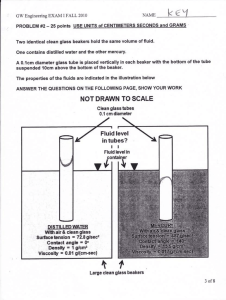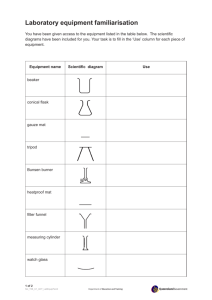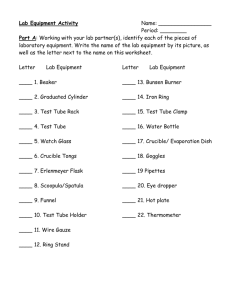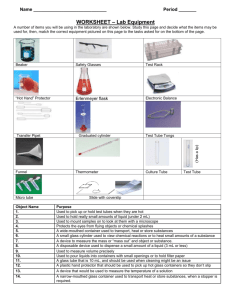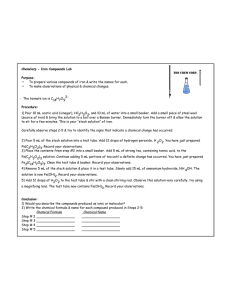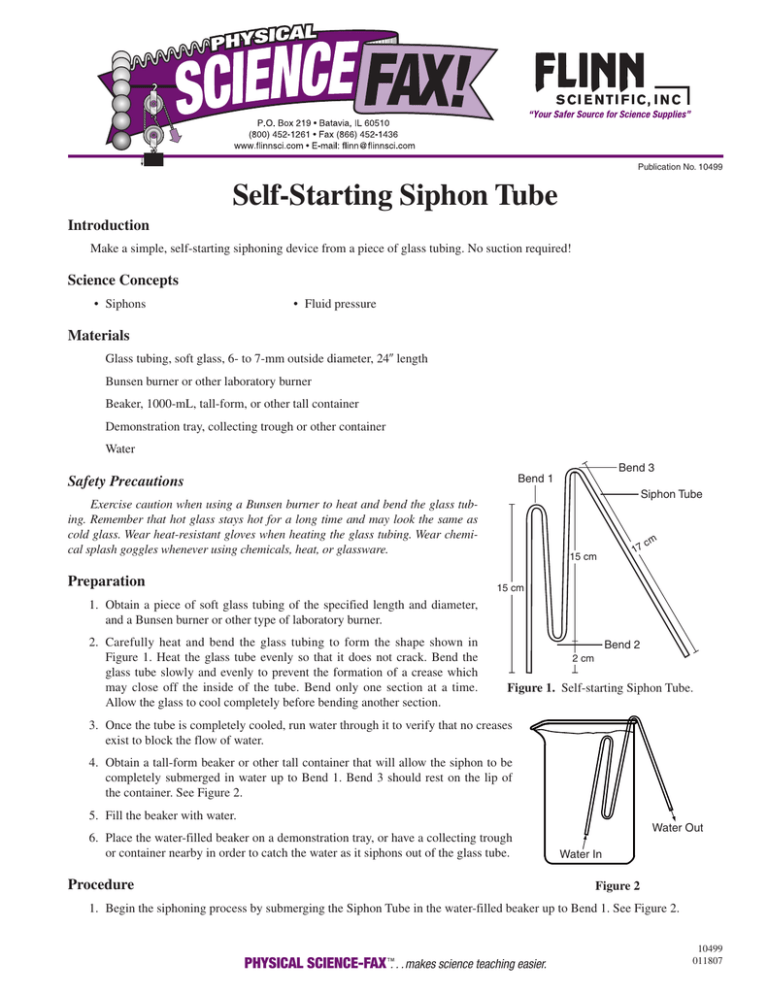
Publication No. 10499
Self-Starting Siphon Tube
Introduction
Make a simple, self-starting siphoning device from a piece of glass tubing. No suction required!
Science Concepts
• Siphons
• Fluid pressure
Materials
Glass tubing, soft glass, 6- to 7-mm outside diameter, 24⬙ length
Bunsen burner or other laboratory burner
Beaker, 1000-mL, tall-form, or other tall container
Demonstration tray, collecting trough or other container
Water
Bend 3
Bend 1
Safety Precautions
Siphon Tube
Exercise caution when using a Bunsen burner to heat and bend the glass tubing. Remember that hot glass stays hot for a long time and may look the same as
cold glass. Wear heat-resistant gloves when heating the glass tubing. Wear chemical splash goggles whenever using chemicals, heat, or glassware.
Preparation
15 cm
17
cm
15 cm
1. Obtain a piece of soft glass tubing of the specified length and diameter,
and a Bunsen burner or other type of laboratory burner.
2. Carefully heat and bend the glass tubing to form the shape shown in
Figure 1. Heat the glass tube evenly so that it does not crack. Bend the
glass tube slowly and evenly to prevent the formation of a crease which
may close off the inside of the tube. Bend only one section at a time.
Allow the glass to cool completely before bending another section.
Bend 2
2 cm
Figure 1. Self-starting Siphon Tube.
3. Once the tube is completely cooled, run water through it to verify that no creases
exist to block the flow of water.
4. Obtain a tall-form beaker or other tall container that will allow the siphon to be
completely submerged in water up to Bend 1. Bend 3 should rest on the lip of
the container. See Figure 2.
5. Fill the beaker with water.
6. Place the water-filled beaker on a demonstration tray, or have a collecting trough
or container nearby in order to catch the water as it siphons out of the glass tube.
Procedure
Water Out
Water In
Figure 2
1. Begin the siphoning process by submerging the Siphon Tube in the water-filled beaker up to Bend 1. See Figure 2.
PHYSICAL SCIENCE-FAX姠. . .makes science teaching easier.
10499
011807
2. Water will begin to empty out of the beaker and pour out the open end of the Siphon Tube. The siphoning process will continue until the level of the water in the beaker decreases to the same level (height) as the open end of the Siphon Tube.
3. Discuss the results with your students.
Disposal
Save the Self-Starting Siphon Tube for future demonstrations.
Tips
• It may take practice to heat and bend the glass tubing 180º. Using a burner wing top to produce a broad, fan-shaped flame
may aid in the glass-bending process. Work slowly on each bend to produce a smooth, even bend. Allow the bend to cool
completely before starting on a new bend. Please refer to your current chemistry textbook or laboratory manual for the
proper techniques to bend glass.
• Quickly plunging the end of the Self-Starting Siphon Tube into the water will increase the speed of the water through the
tube and help initiate the siphoning process.
• The siphon will also work if water is poured into the beaker until the water level rises above Bend 1.
• Glass tubing works better than plastic tubing because of the stronger capillary action of glass. Also, plastic tubing tends to
crease more easily.
• Place the water-filled beaker directly next to an empty beaker. As you submerge the Siphon Tube into the water, place the
spout end of the siphon inside the empty beaker. As the siphoning process occurs, water will drain out of the water-filled
beaker and fill the empty beaker. The water will continue to siphon out of the first beaker even after the water level in the
second beaker reaches the open end of the siphon spout. Since no motion of the water flow can be seen, it will appear as
if the water is mysteriously draining from first beaker and filling the second. The siphoning process will continue until the
level of the water in both beakers reaches the same height.
• When the water is mysteriously siphoning out of the beaker and into another beaker (the water flow is not visible), add a
drop of food coloring into the siphoning beaker and watch the dye get pulled into the tube.
• Use the Self-Starting Siphon Tube to “magically” start a chemical reaction, such as an acid–base indicator reaction. Fill
one beaker 3⁄4-full with a 0.1 M sodium hydroxide, NaOH, solution. Fill a second beaker completely full with water and
5-mL of phenolphthalein indicator solution. If the solution is pink, add a few drops of 0.1 M hydrochloric acid, HCl, solution until the solution turns colorless. Submerge the Self-Starting Siphon Tube into the water/phenolphthalein solution as
you aim the open end of the tube into the beaker containing the sodium hydroxide solution. When the solutions mix, a pink
color will “magically” appear.
Discussion
A siphon “pulls” water out of a container because of a difference in pressure between the two open ends of the tube. The
pressure (Ph) at a given depth below the surface of a liquid is equal to the atmospheric pressure at the surface of the water plus the
pressure exerted by the liquid, which is proportional to the depth beneath the surface (ρgh). See Equation 1.
Ph = Po + ρgh
Ph =
Po =
ρ =
g =
h =
Equation 1
Pressure at a given depth below the surface of a liquid
Atmospheric pressure at the surface of the liquid
Density of the liquid
Acceleration due to gravity constant
Depth beneath the surface of the liquid
For a siphon, the atmospheric pressure will be approximately equal at both ends of the tube. The pressure difference arises
from the difference in length of the two columns of liquid in the upside-down, U-shaped tube. A simple siphon is shown in
Figure 3. In Figure 3, it shows that the liquid-filled columns produce a downward pressure which partially cancels the effect of
atmospheric pressure that is forcing the liquid into the tube. However, the short column (a) produces less downward pressure
compared to the long column (b). Therefore, the short column does not cancel the effect of atmospheric pressure as much as the
long column. The total pressure at the open end of the long column is smaller than at the submerged end of the short column.
–2–
© 2007 Flinn Scientific, Inc. All Rights Reserved.
10499
This pressure difference causes the liquid to flow from high pressure to low pressure, and thus into the submerged end of the
tube, up the column, over the peak, down the long column and out the open end.
Po
h1
Pressure at Point A (submerged end):
h h0
a
b
PA = Po + ρgho – ρgh, where h = ho + h1
ρgh
= Po – ρgh1
A
h2
P0 + ρgh0
Pressure at Point B (open end):
PB = Po – ρgh2
ρgh2
If h2 > h1, then PA > PB
B
P0
If h2 = h1, then PA = PB
Figure 3
Two conditions must be present for a siphon to work. First, the siphoning tube must be completely filled with a liquid before
the siphoning process will begin. No gas bubbles can be trapped inside the tube. Gas bubbles will provide additional pressure
inside the tube and will disrupt the pressure difference between the ends of the tube. The second condition is that the open end of
the siphon must be below the height of the surface of the liquid that is being siphoned. If the open end is at the same level as the
surface of the liquid in the container, then the heights of the liquid columns in the U-shaped tube would be equal. Therefore, no
pressure difference is created to push the liquid out of the container. If the open end is raised above the surface of the liquid in the
container, then the pressure difference between the ends of the tube will reverse. The submerged end will have a lower pressure
than the open end, and the liquid will flow back through the siphon into the container.
The Self-Starting Siphon Tube uses the properties of momentum, cohesion, and capillary action to initially “pull” water out
of the beaker and initiate the siphoning process. When the Siphon Tube is submerged into a beaker of water, water flows into the
submerged end because of a pressure difference due to the surrounding water. The water attempts to reach an equilibrium level by
flowing through the looping tube to get to the same height as the surface of the water in the beaker. The bends in the tube prevent
this from happening, so water continues to flow through the tube. The momentum of the flowing water, combined with the capillary action of the glass tube, is strong enough to allow the water in the tube to flow above the surface of the water in the beaker,
over the peak in the loop, and down the open column. Once the water flows over the peak, the cohesiveness of the water “pulls”
more water from the beaker along with it until water flows out of the open end of the tube and the siphoning process begins. Once
the water flows out the open end, it is the pressure difference between the two ends that keeps the water flowing out of the beaker
just like an ordinary simple siphon.
Connecting to the National Standards
This laboratory activity relates to the following National Science Education Standards (1996):
Unifying Concepts and Processes: Grades K–12
Evidence, models, and explanation
Content Standards: Grades 5–8
Content Standard B: Physical Science, understanding of motions and forces
Content Standards: Grades 9–12
Content Standard B: Physical Science, motions and forces
Materials for the Self-Starting Siphon Tube are available from Flinn Scientific, Inc.
Catalog No.
GP9030
Description
Glass Tubing, Soft Glass, 24⬙, 7 mm OD
Consult your Flinn Scientific Catalog/Reference Manual for current prices.
–3–
© 2007 Flinn Scientific, Inc. All Rights Reserved.
10499



